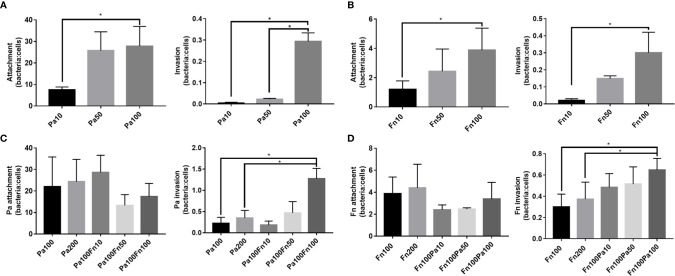Figure 2.
The adherence and invasion of P. aeruginosa and F. nucleatum to pulmonary epithelial cells. (A) The attachment and invasion of P. aeruginosa to pulmonary epithelial cells. A549 cells were infected with different MOI (10, 50, 100) of P. aeruginosa. (B) The attachment and invasion of F. nucleatum to pulmonary epithelial cells. A549 cells were infected with different MOI (10, 50, 100) of F. nucleatum. (C) The effect of F. nucleatum on the attachment and invasion of P. aeruginosa. A549 cells were simultaneously infected with P. aeruginosa (MOI 100) and F. nucleatum (MOI 10, 50, 100), and the single P. aeruginosa infection groups (MOI 100, 200) were used as control. (D) The effect of P. aeruginosa on the attachment and invasion of F. nucleatum. A549 cells were simultaneously infected with F. nucleatum (MOI 100) and P. aeruginosa (MOI 10, 50, 100), and the single F. nucleatum infection groups (MOI 100, 200) were used as control. *P < 0.05, statistics were achieved by analysis of variance followed by Sidak’s multiple comparisons test. Pa, P. aeruginosa; Fn, F. nucleatum.

